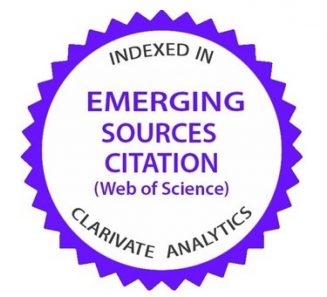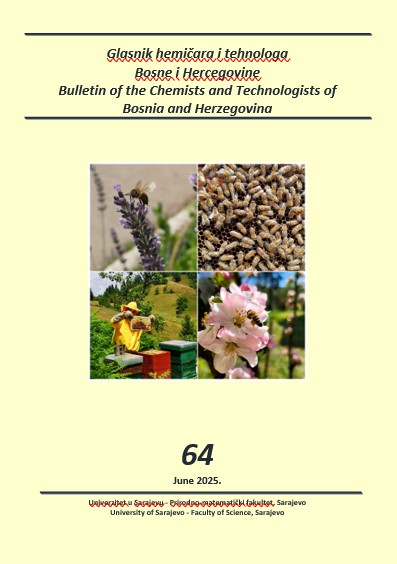|
|
Bulletin of the Chemists and Technologists of Bosnia and Herzegovina
Issue 64
Publication date: June 2025 |
|
Table of contents
Evaluation of Nicotine Transdermal Patches Available on the Domestic Market Original Scientific Article
Uzunović, A., Mlivo, E., Pilipović, S., Šljivić Husejnović, M., Šapčanin, A., Pilipović, B.
DOI: 10.35666/2232-7266.2025.64.01
UDK: 543:613.84
Abstract: The use of transdermal patches with nicotine is a better way to quit smoking because it ensures a similar concentration of nicotine in the blood as when smoking and reduces the morning desire for a cigarette. The aim of this work was to analyze the behavior of the matrix with the active substance under conditions that are close to skin conditions. A total of 3 samples were collected from local market. The analysis was performed after 0.5, 1, 4, 10, 16 and 24 hours for each sample. The concentration of released nicotine for samples at 50 RPM ranged in the following range: sample 1 43.87 %-115.23 %; sample 2 40.56 %-114.70 %; sample 3 43.53 %-117.13 %. The concentration of released nicotine for the samples at 100 RPM ranged in the following range: sample 1 45.14 %-120.82 %; sample 2 49.05 %-120.79 %; sample 3 44.73 %-118.51 %. It was determined that most of the nicotine is released already after 4 hours. The samples also show very similar concentration results after 10 hours, and for all three samples the result was 0.096 mg/ml.
Bulletin of the Chemists and Technologists of Bosnia and Herzegovina 64, 01-05
Bioeconomy and the Modern Challenge of Sustainable Production and Consumption of Biomass and Biofuels Original Scientific Article
Papuga, S., Djurdjevic, M., Kotur, M.
DOI: 10.35666/2232-7266.2025.64.02
Abstract: The bioeconomy encompasses the whole economy’s reliance on biological and renewable resources, appears as a response to the global challenges confronting the present civilization. This paper explains the genesis of this concept, focusing particularly on its fundamental components, i.e. the sustainable utilization of biomass and the production of biofuels. It offers an overview of global policies and strategies in this domain, alongside the potential applications of biomass. A large number of studies highlight the great potential of biomass, surpassing the current human needs. However, its application has to be examined through three aspects: supply, demand and sustainability. The increase in biofuel production also imposes challenges such as the competitive use of land for biomass and food production, which is a particular problem, and in this regard, various technologies have been developed that use inedible biomass in the production of biofuels and valuable chemicals. Recognizing the importance of the bioeconomy, as an inevitable element in achieving sustainable development, the European Union adopted a strategy and action plan for the bioeconomy in 2012. Also, many countries that are important players in the global economy, such as the United States, Germany, Canada, Japan, etc. have adopted their national strategies that promote the bioeconomy. It is clear that there is a global interest in research and investment in supply chains for biomass and biofuels, which gives an optimistic picture of the future use of biomass as the basis of a future global bioeconomy.
Bulletin of the Chemists and Technologists of Bosnia and Herzegovina 64, 07-22
New insight into the geochemical behavior of alkali and alkaline earth metals in a frequently subsampled clay pit sample with and without Al-normalization Original Scientific Article
Jurković, J.*, Sijahović, E., Bašić, F.
DOI: 10.35666/2232-7266.2025.64.03
UDK: 552.23[543:546]
Abstract: Clays are fine-particle-size materials (less than 2 μm) comprised mainly of clay minerals, which are hydrated aluminum silicates with associated alkali and alkaline earth elements. The small particle size and complex porous structure result in a high specific surface area, which allows strong physical and chemical interactions with dissolved species. Metals can also be incorporated within the clay structure, which can be made of octahedral and/or tetrahedral sheets. Depending on the composition of the tetrahedral and octahedral sheets, the layer will have no charge or will have a net negative charge. If the layers are charged, this charge is balanced by interlayer cations. The recent research of metals in clays mainly focused on heavy metals, while investigations of light metals are rather rare. For the investigation of the behavior of alkali and alkaline earth metals in clay samples, 110 subsamples of cored samples were taken. The total contents of potassium (K), magnesium (Mg), calcium (Ca), sodium (Na), strontium (Sr), and barium (Ba) were determined using inductively coupled plasma-optical emission spectroscopy (ICP-OES). Descriptive statistics were conducted using maximum, minimum, average, and median values. Correlation and PCA analysiswith and without Al-normalization were calculated to determine the different behavior of metals, The contents of metals lie in the following sequence: K>Mg>Ca>Na>Ba>Sr. The highest correlation between metals was found between Mg and K (r=0.87) and Ba and Sr (r=0.65). PCA analysis revealed two subgroups: 1) K, Mg, Na. 2) Ba, Sr. After the Al normalization was applied, Ba and Sr showed the highest correlation (r=0.81). Ca did not significantly contribute to any of the PCA subgroups, suggesting a possible different source and behavior.
Bulletin of the Chemists and Technologists of Bosnia and Herzegovina 64, 23-31
Antioxidant Properties of Alien Plant Species: Assessing Phenolic and Flavonoid Content, Antioxidant, Oxidant Capacities, and Antimicrobial Activity Proceedings
Burović, S., Pašić, L., Madacki-Todorović, K. Sarajlić, N., Galijašević, S.
DOI: 10.35666/2232-7266.2025.64.04
UDK: 542.943'78:634-1/-2
Abstract: Alien plant species pose significant threats to natural ecosystems due to their adaptability and invasive potential. In this study, the antioxidant activity of 13 alien and invasive plant species was investigated, regarding their total phenolic content, flavonoid content, total antioxidant capacity, total oxidant capacity, and antimicrobial activity. Plant tissues were macerated, evaporated to dryness, and the extracts were dissolved in water. Total phenolic content ranged from 6.55 mg GAE/g extract to 30.82 mg GAE/g extract. Flavonoid content spanned from 3.04 mg Quercetin/g extract to 40.81 mg Quercetin/g extract. The total antioxidant capacity ranged between 662 CEAC µM and 1540 CEAC µM. Total oxidative capacity can be correlated to the abiotic stress. Rhus typhina L. and Impatiens balfourii Hooker f., exhibited positive total oxidant capacity values of 122.56 ± 7.85 µM H₂O₂ Equiv./L and 141.38 ± 4.33 µM H₂O₂ Equiv./L, respectively. These two species also showed the highest total antioxidant capacity that were 1190,06 ± 137,36 CEAC µM for Rhus typhina L and 1540,34 ± 270,84 for CEAC Impatiens balfourii Hooker f. The results suggest that the extraction solvent significantly affects the antioxidant capacity, with ethanol generally providing higher extraction efficiency for many species. The antimicrobial activity was determined against Escherichia coli, Staphylococcus aureus, Proteus mirabilis, Pseudomonas aeruginosa, and Candida albicans. Rhus typhina L was active against E. coli and P. mirabilis.
This data indicates that plants increased antioxidant defense systems against abiotic stresses. Clearly, the correlation between total oxidant capacity and total antioxidant capacity values in plants is a valuable factor indicating the mechanism of the plant defense.
Bulletin of the Chemists and Technologists of Bosnia and Herzegovina 64, 33-42
Content of Total Phenolics, Total Flavonoids and Vitamin C, and Antioxidant Activity of Selected Raspberry Varieties Proceedings
Topčagić, A., Muftić-Brdar, D. , Klepo, L., Mujezin, A., Toromanović, J., Tahirović, I.
DOI: 10.35666/2232-7266.2025.64.05
UDK:582.711.712:577.164.2(497.6 Cazin)
Abstract: This paper presents the study of total phenolics (TPs), total flavonoids (TFs), vitamin C and antioxidant activity (AA) of fruits and juices of raspberry varieties from the area of the municipality of Cazin. Five raspberry varieties (Fertodi, Meeker, Polka, Tulameen, and Willamette) grown according to the integral concept, as well as one sample of the Willamette variety grown as a hobby within the homestead - semi-intensive concept (W-sc) were analyzed. The TPs (before and after precipitation with formaldehyde) were quantified using the Folin-Ciocalteu method with gallic acid (GA) as a standard. The TFs were calculated from the difference between the TPs before and after precipitation. To determine the content of vitamin C, L-ascorbic acid (AsA) was utilized as a standard. In addition, the AA of the raspberry samples was tested using the ABTS radical scavenging method, using trolox (T) as a standard. The highest TPs content in fresh raspberry fruits (f.f.) was shown by the Tulameen variety (1608.77 mg GAE/100 g), while the W-sc sample showed the highest TPs content (1417.65 mg GAE/100 mL) among fresh raspberry juices (f.j.). The Tulameen variety had the highest TFs in f.f. (1513.81 mg GAE/100 g) and the Willamette variety in f.j. (789.99 mg GAE/100 mL). The highest content of vitamin C was shown by the variety Meekerin both tested raspberry fractions (45.87 mg AsAE/100 g in f.f., and 37.42 mg AsAE/100 mL in f.j.). All samples exhibited AA, whereby the best AA was shown by the Fertodi variety (7.60 mM TE/g) for f.f. samples, while the Meeker variety had the highest value of AA (6.26mM TE/mL) among f.j. samples.
Bulletin of the Chemists and Technologists of Bosnia and Herzegovina 64, 43-48



